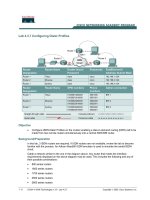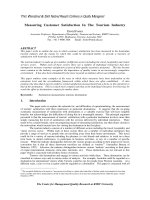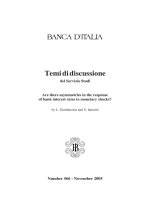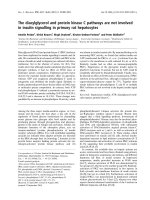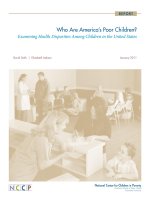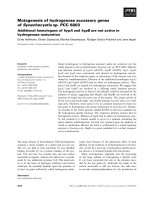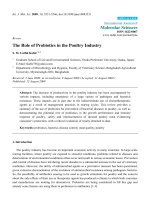REASONS WHY HORMONES ARE NOT USED IN THE POULTRY INDUSTRY ppt
Bạn đang xem bản rút gọn của tài liệu. Xem và tải ngay bản đầy đủ của tài liệu tại đây (549.6 KB, 5 trang )
North Carolina State University and North Carolina A&T State University commit themselves to positive action to secure equal opportunity regardless of
race, color, creed, national origin, religion, sex, age, or disability. In addition, the two Universities welcome all persons without regard to sexual orientation. North
Carolina State University, North Carolina A&T State University, U.S. Department of Agriculture, and local governments cooperating.
North Carolina Cooperative Extension Service
Union County Center
500 N. Main Street, Room 506
Monroe, NC 28112-4796
Phone: 704-283-3743
Fax: 704-283-3734
Email:
Issue Editor and Layout:
North Carolina Poultry
Industry Newsletter
Jody Smith, Area Specialized Agent, Poultry
November, 2004
REASONS WHY HORMONES
ARE NOT USED IN THE
POULTRY INDUSTRY
K. E. Anderson and A. G. Gernat
Department of Poultry Science
Every parent is concerned for the welfare and health of their
child. However, with the proliferation of misinformation
everywhere the following situations are becoming more
prevalent.
Wouldn't you know my little boy received a free coupon to KFC
from a coloring contest? We have planned to use it tonight but
our son had questions concerning the safety of the food we were
going to get at the restaurant. He had heard in school that
hormones are being fed to animals to supply meat and this made
the chicken unsafe and unhealthy to eat. How should we respond
to these types of questions? As a parent, I really don't think that
I will change my plans since we seldom go out to eat, but there
are people who go every day. Should we really be concerned?
As a parent I have faced this situation with my own children and
I deal with it using truth and knowledge from reliable sources. I
know it is hard to actually know what the truth is in these
situations, and not all of the information on the Internet is
truthful, so the source has to be a trusted one.
Sources of information that are most reliable are typically
associated with the federal government. The Food and Drug
Administration and the United States Department of Agriculture
have both developed reports and sponsored research looking at
the issues of hormones in the poultry industry in depth. However,
these reports tend to be highly technical and difficult to
understand even for those trained in the sciences. The second
source is the Extension Service located in every state. These
scientists in the Extension Service take these complicated reports
and boil them down to the basic facts and realities that the public
can understand.
The Poultry Industry does not use hormones:
Let’s start with the question about hormones that Extension
specialists and agents hear from the public. “Why do you add
hormones into chicken feed?” The simple truth is hormones are
not added to poultry feeds. This fallacy is fueled by inaccurate
statements made by The World Health Organization that
apparently has issued a plea to stop giving growth hormones to
chickens grown for human consumption. Supposedly the
American Medical Association, the American Public Health
Association, and other medical groups are in agreement even;
however, the poultry industry does not feed hormones to their
birds. The basic assumption by the public has become a common
practice is to ask “Why” rather than “If”. Currently some poultry
companies are even stating on their advertising and labeling that
they do not use hormones. This statement does not resolve the
question in the mind of the public. In fact, it may be creating a
bigger cloud! Since some companies actively claim that they do
not use hormones in poultry, and other do not disclaim the use of
them, the public is distrustful of these companies that do not state
their stance. The way the poultry industry is addressing this issue
raises some doubt in the minds of the public. They hear how
rapidly broilers and turkeys grow and how many eggs a layer
will produce thus; making the assumption that the poultry
industry has a “magic bullet” which the public presumes is the
use of hormones.
This perception of a "magic bullet" is totally inaccurate, and
detracts from the fact that the poultry industry has developed in
to a very efficient animal production industry with birds that
have been selected for rapid growth, high production, and
excellent feed efficiency.
This Issue Includes
Reasons why hormones are not used in the poultry
industry…………………………………………………………1
Fall rodent management practices…………………………3
Infectious Laryngotracheitis Virus (ILT)……… ……… 3
Being a good neighbor…………………………………… 5
North Carolina Poultry Industry Newsletter Page 2 November, 2004
North Carolina State University and North Carolina A&T State University commit themselves to positive action to secure equal opportunity regardless of
race, color, creed, national origin, religion, sex, age, or disability. In addition, the two Universities welcome all persons without regard to sexual orientation. North
Carolina State University, North Carolina A&T State University, U.S. Department of Agriculture, and local governments cooperating.
Why hormones are not used:
There are a number of reasons why hormones are not used in the
poultry industry. In the United States, European Economic
Community, and most other developed countries there are
extremely strict controls concerning the use of hormones and
hormone-like substances against their use in animal feeds. In
other words it is illegal. Allegations have been made that illegal
use of hormones has occurred, however, there is no logical
reason to use them in poultry production.
Broiler growth would not be increased with the use of hormone
additives. The genetic selection that developed today’s broiler
has resulted in an animal that multiplies its hatch weight by 65
times within a seven-week period. In many cases this is hard for
the public to believe. The genetic selection has resulted in an
animal which grows to its physiological limit. Like in children
who experience a growth spurt during puberty, and have
resultant joint inflammation and pain, the broiler lives on this
same physiological edge. In fact, it is occasionally
recommended that we restrict growth of the broilers in order to
enhance their health and well-being. It would be counter
productive to try and stimulate a broiler, layer or turkey to
exceed their physiological growth limit. If this was done it
would most certainly result in a doubling, tripling, and possibly
quadrupling of the mortality rate. This would be highly counter
productive.
Contacts for the North Carolina
Poultry Industry Newsletter
On-Campus Contact
Brian W. Sheldon, Ph.D., Dept Extension Leader
Dept of Poultry Science, NCSU
www.ces.ncsu.edu/depts/poulsci/
email:
telephone: 919-515-5407
Field Faculty Contacts
Kathy Bunton, Area Specialized Agent, Poultry
*Iredell, Wilkes and Alexander Counties
www.ces.ncsu.edu/iredell/
email:
telephone: 704-878-3154
Dan Campeau, Area Specialized Agent, Poultry
Chatham*, Harnett, Lee, Moore and
Randolph Counties
www.ces.ncsu.edu/chatham/
email:
telephone: 919-542-8202
James Cochran, Area Specialized Agent, Poultry
Bladen, Columbus, Cumberland, Hoke and
*Robeson Counties
www.ces.ncsu.edu/robeson/
email :
telephone: 910-671-3276
James Parsons, Area Specialized Agent, Poultry
*Duplin, Sampson and Wayne Counties
www.ces.ncsu.edu/duplin/
email :
telephone: 910-296-2143
Jody Smith, Area Specialized Agent, Poultry
Anson, Cabarrus, Montgomery, Richmond,
Scotland, Stanly and *Union Counties
www.ces.ncsu.edu/union/
email:
telephone: 704-283-3743
(*Administratively housed in this county.)
The hormones which may enhance growth are actually proteins.
Therefore, if they were consumed in the feed they would be
digested in the same way as the corn or soybean meal that they
eat. The only way for a growth hormone to be effective would
be to inject it everyday in the same manner as Insulin is to treat
diabetes. Logically speaking it is physically impossible to inject
the 5 billion broilers grown annually in the US each and every
day.
Chicken growth hormone is produced for use in scientific
research, which means it is not produced on a commercial basis
and is extremely expensive and as such makes no commercial
sense to use.
It is prevalent in the press about the abuse of anabolic steroids in
sports athletes. There is no doubt that their use leads to
increased muscle mass. However, they only work in athletes
when they are taken in combination with rigorous physical
training. Chickens are galliforms, which means they are a
heavily bodied, ground-feeding animal that have had restricted
flight for thousands of years. In other words they do not readily
fly and as such the breast muscle gets limited exercise. This
means that anabolic steroids would not have any growth effect
on broilers since they do not fly or work their breast muscle.
The bottom line: Hormone use in animal production is illegal.
Hormones are not needed to enhance the growth or production of
poultry today. The performance of the broilers, turkeys and
laying hens which are used in the industry today can be easily
explained as a result of genetic selection and nutrition.
Hormones are not even needed:
Three components have contributed to the ability of the birds to
grow and develop which has contributed to the high performance
birds used in today’s poultry industry:
First, is the effectiveness of the genetic selection by the primary
breeders for growth and production of their birds. The breeders
have selected the birds for a particular use such as meat or egg
North Carolina Poultry Industry Newsletter Page 3 November, 2004
North Carolina State University and North Carolina A&T State University commit themselves to positive action to secure equal opportunity regardless of
race, color, creed, national origin, religion, sex, age, or disability. In addition, the two Universities welcome all persons without regard to sexual orientation. North
Carolina State University, North Carolina A&T State University, U.S. Department of Agriculture, and local governments cooperating.
production.
Second, is the research which has been done related to the
nutritional needs of the animal. We know exactly what the levels
of protein, energy, vitamins and minerals are to achieve optimal
growth and performance.
Third, is the understanding of the environmental needs of the
birds. The healthier the environment with adequate feeder,
water, and floor space the better the performance and growth.
Enhanced bird welfare results in improved growth and egg
production.
Generally I respond to my kid's questions stating the above facts
in "kid terms". Telling him the Poultry Industry absolutely does
not use growth hormones, then reminding him of how good KFC
chicken tastes, usually gets him ready to eat without worries.
FALL RODENT
MANAGEMENT REMINDERS
Mike Stringham, Extension IPM Specialist
Fall is rodent time. This means it’s also time to step up your
rodent monitoring and control efforts. Food resources in the
fields and woods are beginning to get scarce for rats and mice
this time of the year, forcing them to move into poultry houses
where food and water are plentiful. Be ready by tightening up
your poultry houses and having plenty of rodenticide on hand.
Start with a walk around the poultry houses. Be alert for signs
of new rodent activity (gnawing, bits of fallen insulation,
droppings, tail marks and tracks). Note the location(s) of these
signs and plan to place baits or traps there. Look for and close
holes and gaps along ridge vents, building corners, and at end
doors. Do the same along building eaves. Nail down loose
siding and corrugated roofing. Cover gaps around feed lines
and conduits where the go through building walls. Think
about two things while doing this chore. First, rats and mice
are excellent climbers, so don’t think a hole is too high off the
ground to need closing. Second, even a small hole can be a
door for rodents. Young rats only need a ½ inch diameter hole
to get in; mice, a hole only ¼ inch in diameter. And, yes, it’s
true that you can’t close up a poultry house like you can your
own home, but limiting the number of entry points improves
the odds that rodents will find the bait you put out before they
ever get into the poultry house.
Once the poultry houses are secure and all signs of new rodent
activity are pinpointed, it’s time to initiate control. Baits
containing bromethalin, bromodialone, brodifacoum,
difethialone, zinc phosphide or cholecalciferol are often the
most effective. These single-dose rodenticides will kill
rodents after 1 to 3 feedings. Older generation rodenticides
containing warfarin, difacinone and chlorophacinone may also
be used, but require rodents to feed continuously for 7 to 10
days.
Place rodenticides in secure bait stations along exterior walls
every 40 feet (maximum interval). Shorter, 20-foot intervals are
recommended where house mice are the primary rodent problem,
but the greater interval is also effective if fresh bait is maintained
in the stations year around. Be sure to place extra stations as
close as possible to those areas where fresh rodent activity has
been noted. Norway rats can also be controlled by placing baits
directly in their burrows. Inspect all bait placements every 2
weeks and replace old bait with fresh as needed. Finally, if
between-flock scheduling permits, be sure that houses are
thoroughly baited after birds and feed are removed. When
poultry houses are empty and feed is scarce, resident rodents are
more inclined to eat the bait you set out for them.
INFECTIOUS
LARYNGOTRACHEITIS
VIRUS (ILT)
Donna K. Carver, DVM, PhD, ACPV
What is ILT?
Infectious Laryngotracheitis virus is a herpes virus that causes
respiratory disease in chickens. ILT is a reportable disease in
North Carolina and some other states. Flocks suspected of
having ILT must be reported to the North Carolina Department
of Agriculture and Consumer Services’ (NCDA&CS)
Veterinary Division.
Where does ILT come from?
Though ILT can be found in chickens throughout the world, it
does not survive for extended periods outside the bird in the
environment. ILT is susceptible to sunlight and most
commonly-used disinfectants. Once infected, chickens become
life-long carriers of ILT and can shed the virus during times of
stress. Chickens are considered to be the source of infection
for other chickens. Virus can be transmitted over short periods
of time on equipment, boots and coveralls.
What clinical signs are present in ILT-infected birds?
Birds infected with ILT initially exhibit signs similar to other
respiratory diseases, including: wet irritated eyes (Fig.1),
sneezing, nasal discharge, failure to thrive, decreased growth,
and decreased egg production. As ILT progresses the clinical
North Carolina Poultry Industry Newsletter Page 4 November, 2004
North Carolina State University and North Carolina A&T State University commit themselves to positive action to secure equal opportunity regardless of
race, color, creed, national origin, religion, sex, age, or disability. In addition, the two Universities welcome all persons without regard to sexual orientation. North
Carolina State University, North Carolina A&T State University, U.S. Department of Agriculture, and local governments cooperating.
signs may become much worse including: difficulty breathing,
bloody discharge from the nose and mouth, gasping (Fig.2),
coughing, and expectoration of bloody mucus. Birds will
shake their heads to clear the mucus from their nose and
mouth, which results in blood stained mucus on the feathers of
many birds in the flock.
Figure 1. Wet irritated eyes
How long does ILT last?
The course of the disease varies with the severity of the
lesions, but most birds recover in 10-14 days.
Will my birds die from ILT?
Again, the severity of the lesions is related to the mortality
seen in flocks with ILT. Mild forms of the disease result in
very low morality (0.1-2%). Severe forms of the disease result
in variable mortality (5-70%) with average being 10-20%.
How is ILT diagnosed?
In ILT infections, clinical signs alone should make you highly
suspicious that you are dealing with ILT. Even so, as with any
disease, you should submit birds to the diagnostic laboratory
in your area for confirmation of the diagnosis. A post-mortem
examination of affected birds will generally reveal blood in the
bird’s airway. The trachea or windpipe is often very bloody
and may be partially clogged with mucus and blood (Fig. 3).
Figure 2. Open-mouth breathing or gasping
Swabs of the trachea will be used to attempt to grow the virus.
Other diagnostic tests may be performed to confirm that your
flock has ILT.
What happens if my flock has ILT?
If you live in North Carolina, where ILT is a reportable
disease, your farm will be quarantined by the NCDA&CS. A
quarantine means that you must have a permit to move birds
onto or off your farm until the quarantine is lifted. Your birds
will be sent to market as quickly as possible with travel to
market via routes determined by the Department of
Agriculture. Lifting of the quarantine is accomplished when
your farm tests negative for ILT two times in a row with the
tests being performed thirty days apart. Before the first of
these tests, your farm must be cleaned and disinfected.
Can people get ILT?
No, human health is not affected by ILT.
Is it safe to eat meat and eggs from birds with ILT?
Yes, because humans are not affected by ILT, and because the
virus is destroyed by cooking, it is safe to eat poultry products
from infected birds.
How can I prevent ILT from infecting my flock?
Preventing the introduction of ILT and other viruses onto your
farm should be the goal of all producers. Preventing the
introduction of ILT into your flock is not difficult to do if you
follow some “common sense” guidelines.
• Avoid moving any birds onto or off your farm
during an ILT outbreak.
North Carolina Poultry Industry Newsletter Page 5 November, 2004
North Carolina State University and North Carolina A&T State University commit themselves to positive action to secure equal opportunity regardless of
race, color, creed, national origin, religion, sex, age, or disability. In addition, the two Universities welcome all persons without regard to sexual orientation. North
Carolina State University, North Carolina A&T State University, U.S. Department of Agriculture, and local governments cooperating.
Figure 3. Trachea filled with blood and mucus
• Do not visit other poultry producers during an
ILT outbreak.
Dr. Bob Hillman, Executive Director of the Texas Animal
Health Commission recommends simple biosecurity measures
that can be taken to help protect flocks:
1. “Keep a spare pair.” Buy a pair of inexpensive rubber
boots, and wear them only on your own premises, to avoid
‘tracking in’ disease.
2. “Give germs the brush off!” Use a long-handled brush to
scrape off manure, mud or debris from tires, equipment or
boots, then disinfect.
3. “Disinfection prevents infection!” Mix a solution of three
parts bleach to two parts water, and use it liberally to clean
rubber boots and equipment brought onto your farm. If
visitors don’t want their vehicle tires sprayed with disinfectant,
ask them to park outside your gate.
4. “Make visitors take cover.” Don’t be shy about asking
visitors to disinfect their footwear or better yet, provide
guests with disposable shoe covers, or footwear worn only on
your place.
If you live in North Carolina and think your flock has ILT,
call NCDA&CS at (919) 733-7601.
Being a Good Neighbor
Dan Campeau, Area Specialized Agent, Poultry
Most poultry producers think of themselves as good neighbors
and for the most part it is true. However, I get about one major
complaint a week dealing with odor issues from spreading
litter and burning mortality. I explain to them that we are not a
regulatory agency but I think the main thing they want is
someone who will listen to them and not ignore their
complaints. The interesting thing is when you talk to the
person it is more of a "timing" issue than an "odor" issue.
Most times the "real" complaint is that the producer spread his
litter during a major holiday or during the time when their
neighbors were having a big family get-together.
In the cases of burning mortality it is more of an issue of
burning during daylight hours when neighbors like to sit out
on their porches and enjoy the fresh country air or conduct out
of the home businesses in their communities.
So realistically what can a producer do to alleviate most of the
problems that lead to complaints?
Maybe some of the following ideas are worth considering.
1. Do not spread litter within 2 weeks prior to a major holiday.
2. Make sure incinerator has an afterburner so that it will cut
down on major odors.
3. Consider incinerating mortality at night, after dark.
4. If spreading litter on crop land, disc the litter in within 48
hours of spreading.
5. Planting a pine/cedar tree curtain around the perimeter of
the property so neighbors and the general public can not see
the poultry houses. Out of sight,, out of mind.
I think the above is a good list to start with but I think also it is
also imperative that producers do not ignore complaints from
their neighbors and try to be accommodating when a neighbor
lets them know about upcoming family gatherings.
Most of the laws and regulations that the allied livestock
industry face today was put in place by politics and all of us
will be judged and regulated in the future by what the poorest
manager is doing with their litter or mortality waste.
Right now the future is in our hands. If we continue to be
good neighbors our friends and neighbors in the surrounding
communities will not go to their commissioners and
lawmakers to crack down on poultry producers like they have
in the swine industry.
So the next time you see a fellow poultry producer not being a
good neighbor, it may be a good idea to at least talk with them
and let them know that if they continue to do as they have
done in the past,,, all of the poultry producers will wind up
being legislated against because of a few bad apples.
